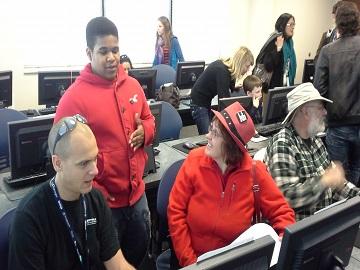
Section Branding
Header Content
Video Game Design Gets Kids Into Coding
Primary Content

Many in the tech world say if today’s kids want to succeed in the job market of the future, they’ll need the skills to design and build their own programs and mobile apps. In other words: they need to know how to code. But how do you get kids interested in the complicated and often frustrating task of coding? One group in Savannah thinks they have the answer.
If someone asked you to imagine an arcade, it probably wouldn’t look much like a well-lit computer lab. It would sound a lot different too.
"It’s way too quiet," says cofounder Kevin Lawver of the Kodestars Arcade at Geekend. "There’s not enough - I should have brought like a soundtrack of like the beeping and the clanging and quarters being spit out."
It’s more than just the setting that makes this different from your typical arcade. Kids created all of these games.
Lawver says that just makes sense. "Kids love games," he explains. "My kids spend hours and hours on it. And there’s this moment when they realize that they can create them that’s just like a brains on the wall kind of thing."
That’s definitely true of 14-year-old Jaire Johnson-Greene. He plays video games all the time. But he says he had no idea he could actually make them.
"I like challenges. So, I thought it was more complicated than what it is, but it seems to be really fun and easy."
As for the games Jaire made? They’re not so easy. He explains one of them, called You Can't Eat Me: "In this game you have to go through a series of water to eat the bug. And if you get in the side of the water, you lose."
It’s a tough maze to navigate. Tough, but addictive. One woman playing it announces, "I’m not gonna quit ‘til I get this guy here." Apparently a lot of people feel that way: this game got the most votes at the arcade.
Jaire’s teacher Juwan Platt says winning is exciting. And so is just seeing people play the students’ games. "If anything," he says, "this was a huge self-esteem booster that they made something and people like it, you know. And really like it."
Platt works for 21st Century Community Learning Centers, which provides after-school programs at high-poverty and low-performing schools. He started the coding class at DeRenne Middle School, where Jaire is in seventh grade.
Platt says the program’s gone a lot more smoothly than he expected.
"I just saw a bunch of barriers that the kids were going to run into, and they completely just ran past them," he says. "I thought I was going to have to explain a bunch of concepts over and over, but actually they started teaching me after a while."
That’s thanks in part to the program they use, called Scratch. Kids click color-coded blocks together to make the instructions that run video games -- instructions like “when you push the up key, the cat jumps.” That way they learn to think like a coder without having to learn a complex coding language.
Kodestars cofounder Yvonne Jouffrault says that’s important whether the kids go into game design or not.
"I think that the process of learning how to create something and following through on that is an important process for kids," she says. "It teaches that ideation and creation, and it gives them a certain level of accomplishment at being able to build something."
Jouffrault and the other organizers say they hope to set up more arcades in the future to get more kids designing and building.
Tags: kodestars, Geekend, coding, kids coding, kodestars arcade, video games, scratch
Bottom Content

